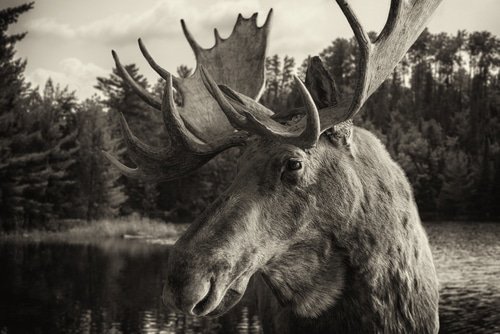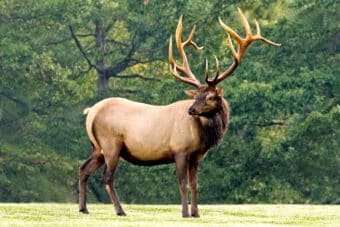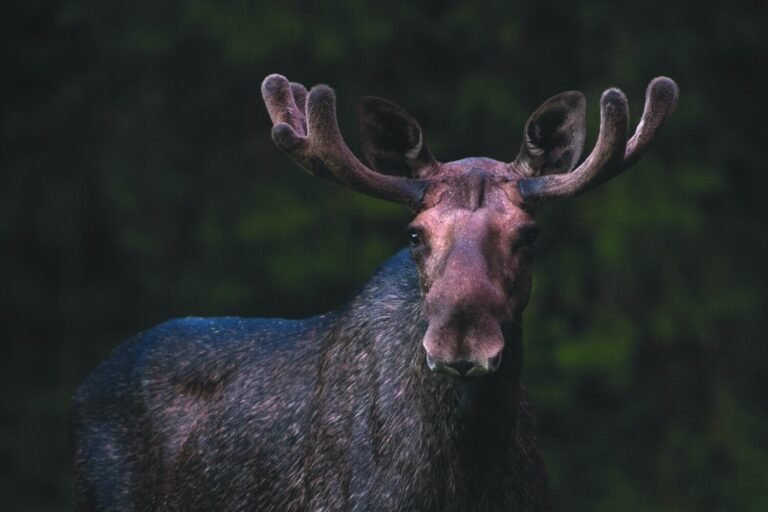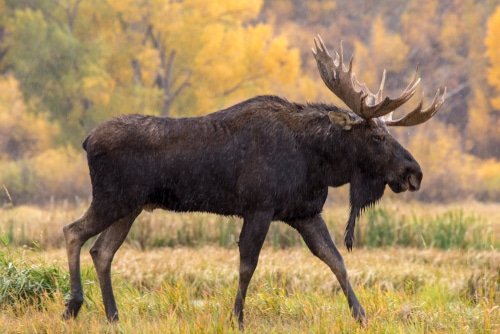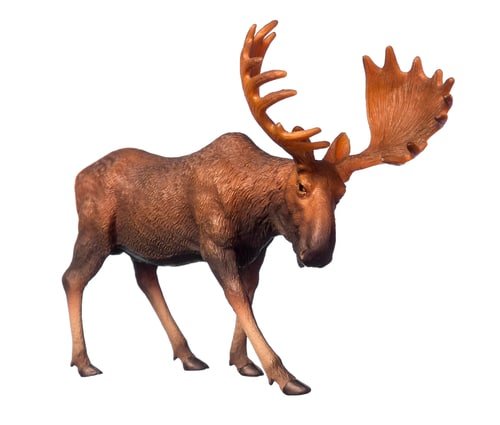The majestic moose – an icon of the wilderness. Majestic, magnificent, and awe-inspiring, the moose is undoubtedly one of the most iconic creatures that roam the pristine landscapes of our wilderness. In this blog we will discuss moose encounter etiquette and why this information is a can’t miss.
With their towering antlers, powerful frames, and gentle demeanor, these majestic animals have captivated the hearts of nature enthusiasts for centuries. However, it is essential to recognize that encountering a moose requires more than just admiration from afar.
Understanding moose encounter etiquette is crucial for a responsible wildlife enthusiast. By gaining insights into their behavior and respecting their space, we can ensure safe moose-viewing experiences while protecting ourselves and these incredible creatures.
The Majestic Moose – An Icon of the Wilderness
When one thinks about the wilderness and its wonders, images of vast forests, tranquil lakeshores, and towering mountains often come to mind. And in these idyllic landscapes resides one particular species that embodies the essence of untamed nature: the moose. This regal being commands attention with its imposing physique—an adult male can reach heights exceeding six feet at the shoulder—and large palmate antlers spanning over six feet across.
Its dark brown fur blends seamlessly with its surroundings as it confidently traverses through dense vegetation or wades through shallow ponds gracefully. For many people who venture into wildlife-rich areas like national parks or remote woodlands, catching a glimpse of a moose in its natural habitat becomes an unforgettable highlight—a symbol of genuine connection with nature’s grandeur.
Importance of Understanding Moose Encounter Etiquette
While observing wild animals can be an exhilarating experience filled with awe and wonderment, it also comes with great responsibility. Respecting wildlife encounter etiquette is crucial for our safety and ensuring these magnificent creatures thrive undisturbed.
Moose, although generally docile and non-aggressive in demeanor, are still wild animals with their own set of instincts and boundaries. Understanding moose behavior is key to harmonious coexistence between humans and these remarkable animals.
Educating ourselves about their habits, communication methods, and potential aggression triggers can minimize the risk of negative encounters while appreciating their presence from a safe distance. Moreover, by adhering to proper moose encounter etiquette, we contribute to conserving their natural habitat and ensure that future generations can also witness the beauty of these magnificent creatures.
Understanding Moose Behavior
Size and strength of a moose – a force to be reckoned with
When encountering a moose, understanding their sheer size and power is crucial. These magnificent creatures are the largest members of the deer family, with adult males, or bulls, weighing up to 1,500 pounds and standing over six feet tall at the shoulder. Antlers spanning up to six feet across command respect and admiration.
It’s important to remember that despite their seemingly calm demeanor, moose possess incredible strength. A simple charge from these majestic beings can be incredibly dangerous, underscoring the need for caution and prudence in any interaction.
Solitary nature – respecting their personal space
Moose are known for their solitary nature; they prefer to roam the wilderness alone rather than in herds like other ungulates. As responsible observers of wildlife, we must respect their personal space.
Approaching too closely can cause distress or provoke aggressive behavior from these otherwise peaceful creatures. Maintaining a safe distance of at least 50 feet is recommended, allowing them to continue undisturbed natural activities.
Seasonal behavior variations – mating season, calving season, etc.
Like other wild animal species, moose exhibit behavioral variations based on seasons and life stages. During mating season in late summer and early fall (known as “the rut”), bulls become more territorial and may exhibit heightened aggression when defending their breeding rights.
It’s critical during this period to exercise extra caution when encountering bull moose. In contrast, calving season occurs in late spring when female moose give birth to adorable calves.
During this time, cow moose can become fiercely protective of their young ones if they feel threatened or perceive any potential danger. Awareness of these seasonal variations allows for safe moose-viewing experiences while respecting their instincts and life cycles.
Approaching a Moose Safely
Maintaining a safe distance – at least 50 feet away
When encountering a magnificent creature like the moose, keeping a safe distance is crucial for your safety and theirs. Experts recommend maintaining a minimum distance of 50 feet between you and the moose.
This allows them to feel comfortable and undisturbed in their natural habitat while allowing you to appreciate their beauty from afar. Respecting this boundary ensures that you won’t inadvertently provoke any defensive behavior or cause undue stress to these majestic animals.
Avoiding sudden movements and loud noises that may startle them
Imagine you’re quietly exploring the wilderness, hoping for a glimpse of a moose in its natural habitat. Suddenly, you startle the unsuspecting creature with an accidental misstep or loud noise.
This could lead to unpredictable reactions, endangering both parties involved. Moving slowly and quietly when approaching or observing moose is important to prevent such unfortunate incidents.
Avoid sudden movements that might surprise or agitate them. Keep conversations calm and turn off any unnecessary electronic devices that could disturb their peace.
Observing their body language for signs of aggression or discomfort
Moose are masters of non-verbal communication, using their body language to express various emotions and intentions. By learning how to read their signals, we can ensure safer interactions with these gentle giants. Signs of aggression may include pinned-back ears, raised hackles (the hair on their neck), stomping hooves, or even charging behavior if things escalate further.
On the other hand, signs of discomfort typically involve restlessness, constant movement in one direction, or repeated glances in your direction without relaxing posture. We can foster responsible and harmonious encounters with moose by paying attention to these subtle cues and respecting their boundaries accordingly.
Remember, a responsible moose encounter means prioritizing their well-being and avoiding any actions that could disrupt their natural behavior. By maintaining a safe distance, being mindful of sudden movements and loud noises, and understanding their body language, we can create an environment that allows us to appreciate the awe-inspiring presence of these magnificent creatures while ensuring our and their safety.
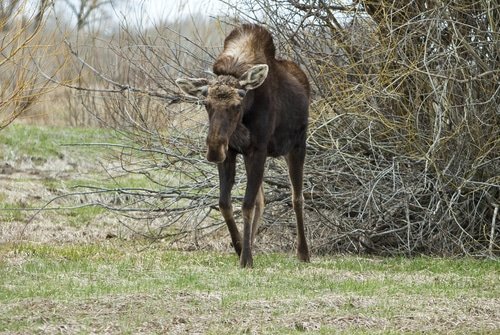
Signs of Aggression in Moose
Ears Pinned Back and Raised Hackles – Warning Signs to Back Off
When approaching a moose, paying close attention to their body language is crucial. One of the clearest indicators that a moose may feel threatened or agitated is when its ears are pinned back against its head. This is their way of saying, “Hey, buddy, I’m not in the mood for company right now!” Additionally, if you spot the moose’s hackles raised along its neck and shoulders, it’s time to give that magnificent beast some space.
These raised hackles are like nature’s warning signpost telling you that getting any closer could be a risky choice. Remember, respecting their boundaries is key to safe moose viewing.
Snorting, Stomping, or Charging Behaviors – Indications of Aggression
Moose aren’t known for their poker faces; they wear their emotions on their gigantic snouts. If you hear a moose snorting loudly and repeatedly, consider it a red flag waving at full mast. Snorting is one way they express annoyance or aggression towards intruders in their territory.
Similarly, if you witness a moose stomping its hooves forcefully on the ground or engaging in mock charges – where it comes towards you but stops short – take these actions seriously. These behaviors show that the moose sees you as a potential threat and wants to establish dominance or drive you away from what they perceive as theirs.
Understanding these signs of aggression can help prevent dangerous encounters with these majestic creatures. Stay tuned for the next section on reacting to an aggressive moose encounter with calm and poise!
Reacting to an Aggressive Moose Encounter
Staying calm and avoiding direct eye contact with the moose
When faced with an agitated or aggressive moose, it is crucial to stay calm. Panicking or making sudden movements can escalate the situation.
Direct eye contact may be a challenge, so avoiding locking eyes with the moose is best. Instead, maintain a relaxed posture and slowly back away.
Slowly backing away without turning your back on them
Retreating from an aggressive moose requires careful movement. It’s important not to abruptly turn your back on them, which might trigger their chase instinct. Take slow steps backward while facing the moose and maintain a side profile to appear less threatening.
Using trees or other objects as barriers, if necessary
If you find yourself in a situation where you need additional protection, try to position yourself behind large trees or any other solid object that can act as a barrier between you and the moose. However, remember that this should only be used as a last resort when no other safe options are available.
Safety Tips for Encountering a Cow Moose with Calves
Keeping an extra safe distance from cow moose with calves
When encountering a cow moose accompanied by her calves, it is especially important to give them ample space. A mother’s protective instincts are strong, and approaching too closely can provoke defensive behavior. Stay at least 100 feet away from these majestic creatures to ensure their well-being and yours.
Recognizing protective behavior such as bluff charges
A cow moose will do whatever she believes necessary to protect her young ones. This may include bluff charges where she runs toward you but stops short of impact.
It is crucial not to run or provoke further aggression. Instead, recognize this behavior as a warning to increase the distance between you and the moose.
Giving the cow plenty of space to ensure her calves’ safety
Respecting the cow’s need to safeguard her calves is essential for their survival. Giving her plenty of space allows a peaceful environment where she can focus on nurturing and guiding her offspring. We contribute to safe moose viewing and responsible moose encounters by being considerate observers.
What to Do If Charged by a Moose
Standing your ground rather than running away
If a moose charges at you, it might be an intimidating experience. However, they resist the urge to flee, which can trigger their chase instinct. Instead, stand firm in one place and show the moose that you are not a threat or prey.
Use bear spray as a deterrent, if available
Bear spray can be an effective deterrent in deterring aggressive moose behaviors. If you have bear spray with you during an encounter, use it by spraying it toward the ground between you and the charging moose. The strong scent irritates their sensitive nasal passages and discourages them from coming closer.
Falling into the fetal position if attacked
In extremely rare cases where all else fails, and a physical attack is imminent, falling into the fetal position can help protect vital organs. Cover your head with your arms while keeping your face down towards your knees. This posture may lessen potential harm during any brief interaction.
Respecting Wildlife and Their Habitat
In our pursuit of nature’s beauty, respecting wildlife and their natural habitats is paramount. Observing animals from a safe distance allows them to thrive undisturbed while ensuring our safety.
Conclusion
Encountering a moose in the wild is an exhilarating experience, but it comes with responsibility. We can ensure safe and memorable encounters by understanding moose behavior, reacting calmly to their aggression, and respecting their space. Let us embrace the wonder of nature while being conscientious stewards, fostering a harmonious coexistence between humans and wildlife.

